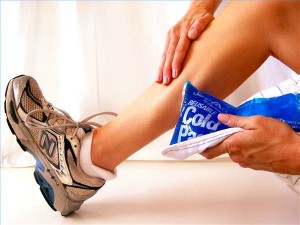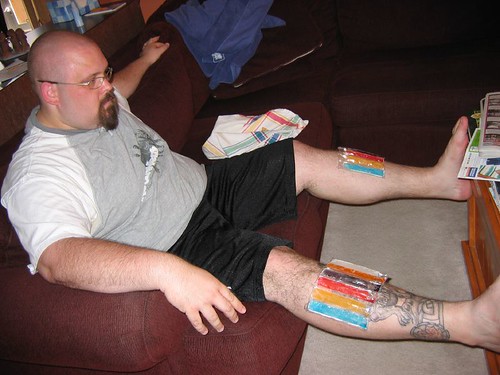With the warmer days coming (and then going, and then coming, and then...) I thought I'd throw in a post about a common injury that can happen to runners when they start hitting the pavement again after spending a season or two indoors on the treadmill...SHIN SPLINTS.
They can be caused by a number of things. Old shoes or wrong kind of shoes, running on hard surfaces when your not used to it, leaning too far forward over your feet while running which causes more strain on your toes, flat arch, running with your toes pointed outward, and sometimes one can get so overzealous that you may be doing too much-too fast.
Symptom
Pain along the medial tibia bone (inner shin bone). At first the pain may stop when activity ceases but after a while it may remain continously.
Treatment
R.I.C.E. - Rest, Ice, Compression, Elevation
Rest - Take a few days off. Easy advice but SO hard to do.
Ice - During the early stage, apply ice to the area for 15- 20 minutes increments. Cryotherapy reduces inflammation and pain by slowing the blood flow. Try writing the ABC's with your foot while you ice to help strengthen and stretch the muscles surrounding the area. After this acute stage, alternate heat with the ice. Applying heat dilates the blood vessels and increases the flow of blood to the tissues to aid healing.
Compression - Applying compression to a wound prevents excessive swelling from occurring and should be applied for about 24-48 hours from the onset of injury (1). There are many kinds of compression wraps and sleeves. Here are a few inexpensive options that provide the needed support.
An ace bandage or tape may also be used just be sure to not wrap it too tight as you could be doing more damage than good. A test, check your toes after 5-10 minutes. If they are discolored or cold, loosen the bandage. For proper taping technique, check out this tutorial.
Elevation - Do just that. The injured limb should be elevated for as long as possible throughout the day for the first 48 hours (1).This slows blood flow to the injured area which again decreases swelling and pain.
Prevention
Prevention is key. Above all, know what kind of shoe you need. If your shoes are a couple years old or you've logged more than 500 miles walking or running (including just wearing them around town), getting some new ones will do you some good. Here's an earlier post that can help you determine what works best for your foot. Also, ease out of the gate. Don't go running full speed ahead at the distance you were running indoors. Introduce your muscles, tendons, and ligaments to the harder and sometimes uneven surfaces gradually.
See ya on the road!
References
1- http://www.sportsinjuryclinic.net/cold_therapy/cold_therapy.php
Compression - Applying compression to a wound prevents excessive swelling from occurring and should be applied for about 24-48 hours from the onset of injury (1). There are many kinds of compression wraps and sleeves. Here are a few inexpensive options that provide the needed support.
An ace bandage or tape may also be used just be sure to not wrap it too tight as you could be doing more damage than good. A test, check your toes after 5-10 minutes. If they are discolored or cold, loosen the bandage. For proper taping technique, check out this tutorial.
Elevation - Do just that. The injured limb should be elevated for as long as possible throughout the day for the first 48 hours (1).This slows blood flow to the injured area which again decreases swelling and pain.
Prevention
Prevention is key. Above all, know what kind of shoe you need. If your shoes are a couple years old or you've logged more than 500 miles walking or running (including just wearing them around town), getting some new ones will do you some good. Here's an earlier post that can help you determine what works best for your foot. Also, ease out of the gate. Don't go running full speed ahead at the distance you were running indoors. Introduce your muscles, tendons, and ligaments to the harder and sometimes uneven surfaces gradually.
See ya on the road!
References
1- http://www.sportsinjuryclinic.net/cold_therapy/cold_therapy.php



4 comments:
Kiesha,
Thank you for following me I just added you to my blog roll. I really like the name of your blog!
Thanks for posting this on Shin splints my bf has them really bad. I miss not running with him, I will share this blog with him.
Here is my question Kiesha, last 10 pounds!!!! Need I say more?
Ugh!! Just starting getting these last week! Not fun. Thanks for the reminder of what I gotta do, like it or not.
MG! He has it all wrong! Those Otter Pops belong in my tummy! He can use something like frozen peas to ice his shins....
Post a Comment